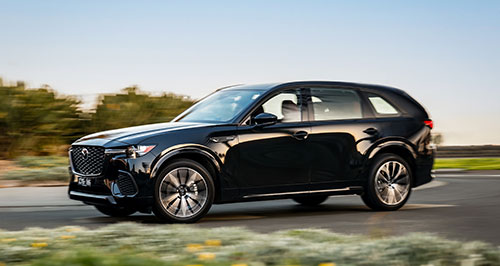Five-seat ‘flagship’ Mazda CX-70 SUV priced
BY MIKE STEVENS | 28th Oct 2024

MAZDA’s SUV range grows again with the Australian introduction of the CX-70, slotting into the new large SUV group as its “flagship” five-seater, priced from $75,970 before on-road costs.
The CX-70 enters the range to sit alongside the seven/six-seat CX-90 as its two-row companion, although its highly-specified two-grade line-up means the newer model starts from a slightly higher price point.
From launch, the CX-70 is available in GT and top-shelf Azami grades only, with petrol and diesel engines available in both trims, along with all-wheel drive as standard.
Pricing for the CX-70 starts from $75,970 + ORC for the six-cylinder turbo-petrol GT and tops out at $84,970 + ORC for the Azami in six-cylinder turbo diesel form.
For the CX-90, the presence of a Touring grade at the entry end makes its starting price a toucher cheaper at $74,550 + ORC, although it climbs quickly to $85,530 + ORC for the GT and on to $101,300 + ORC for the extra-special Azami SP and Takumi models.
Along with the CX-70 and CX-90, Mazda also offers ‘narrow body’ CX-60 and CX-80 models in Australia, filling similar two- and three-row roles at more affordable prices.
“This is a key moment for Mazda Australia. As we move into the next generation of our brand, these four trailblazers all play their own distinct role in sustaining our ambition to offer an unrivalled breadth of choice for our customers,” said Mazda Australia managing director Vinesh Bhindi at the CX-70’s local unveiling in June.
Visually similar to the CX-90, the CX-70 is differentiated only by model-specific bumper covers, blackened exterior trim, and its own unique alloy wheel designs.
Like its three-row sibling, the CX-70 is driven by a choice of petrol and diesel engines, producing the same outputs in both lines.
The G50e is a 245kW/500Nm 3.3-litre, inline six-cylinder turbocharged petrol engine, while the D50e is a 187kW/550Nm inline turbo diesel with the same capacity and cylinder count.
Each powertrain option integrates Mazda’s ‘M Hybrid Boost’ 48V mild hybrid system, and both are matched to Mazda’s own in-house eight-speed automatic transmission and rear-biased all-wheel drive.
Both GT and Azami variants ride on 21-inch black metallic alloy wheels.
Inside, the CX-70 is effectively identical to the CX-90 but for the absence of a third row, and each model grade gets the same 12.3-inch main display and matching 12.3-inch TFT instrument cluster.
Standard kit for the CX-70 GT includes adaptive LED headlights, a panoramic sunroof, heated steering wheel, and heated leather seats with driver-side power adjustment and memory settings.
There is also a Bose 12-speaker audio system with wireless Apple CarPlay and Android Auto, a hands-free power tailgate, and a 360-degree view monitor for enhanced urban and parking manoeuvrability.
Stepping up to the Azami adds a ‘See-Through’ 360-degree monitor and ambient lighting in the cabin. Additional design elements include body-colour wheelarches and door handles, a frameless interior mirror, front ventilated seats, and foot lamps in both front and rear seating areas.
Buyers can choose either black or burgundy Nappa leather seat trim without additional cost, but Mazda also offers an SP Package the Azami – at an extra $3500 – adding tan Nappa leather seats, a suede-finish dashboard, and a two-tone steering wheel.
Driver assistance features include lane-keep assist, blind-spot monitoring with vehicle exit warning, and smart brake support with cyclist and pedestrian detection. A new function called unresponsive driver support monitors for signs of driver distraction or drowsiness and can bring the vehicle to a stop if needed.
Mazda Connected Services is standard across the range and integrates with the MyMazda phone app, providing access to remote functions like locking, geofencing, curfew notifications, and stolen vehicle tracking.
Boot space is listed at 923 litres with the rear seats upright, expanding to 2015 litres when the rear seats are folded.
2025 Mazda CX-70 pricing for Australia
|
CX-70 GT petrol (a)
|
$75,970
|
|
CX-70 GT diesel (a)
|
$77,970
|
|
CX-70 Azami petrol (a)
|
$82,970
|
|
CX-70 Azami diesel (a)
|
$84,970
|
*Prices exclude on-road costs